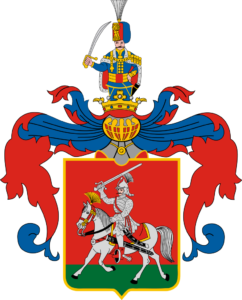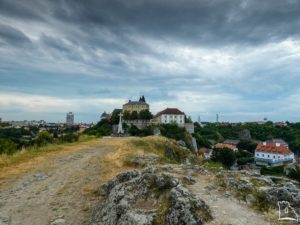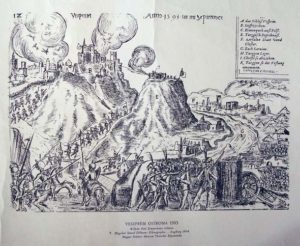Veszprém

Veszprém is one of the oldest urban areas in Hungary and a city with county rights. It lies 12 km north of Lake Balaton, on the southern slope of Bakony Mountain. The fort was built on a 40-meter-high and 400-meter-long stone plateau, its width is 90 meters. The Séd Stream is flowing at the foot of the castle hill, going around the steep cliff wall. The place was inhabited in the Bronze Age and there was an earthen castle in 1,000 B.C. but the Romans didn’t settle there. According to legend, Veszprém was founded on seven hills. However, the castle was probably a 9th-century Frankish fortress.

The castles of Veszprém, Esztergom, and Székesfehérvár, were the earliest Hungarian stone castles. We know that the area of Veszprém used to be the tribal land of the Árpád’s clan as the place names of the surrounding lands prove it: Jutas (Árpád’s son), Fajsz (the grandson of Árpád), Tevel (another grandson of Árpád), and Nemesszalók (the father of Ösbő). In fact, it was the army of Ösbő who took Veszprém castle from the Franks after a hard 7-day-long siege, according to the Hungarian chronicler Anonymus.

King Stephen (István) I of Hungary defeated the armies of his chief opponent, Koppány, near Veszprém when the army of Prince Koppány (Cupan dux) was besieging the fort. The city became the first episcopal seat of Hungary in 1009, and the seat of a Comes. Because the city belonged to King István’s wife, Queen Gizella, it became the town of the future Hungarian queens’.

During the 13th-century Mongol invasion of Hungary, Veszprém was protected by its castle. For centuries, the queens of Hungary were crowned by the bishop of Veszprém. The city is still often called “the City of Queens”. The castle was first mentioned in writing in 1206 as “Bespremiensis castri”. The comes of Veszprém castle was mentioned in 1237: at this time, the stone castle consisted of the initial inner castle.

It is supposed that the castle was not besieged by the Mongols in 1241-42 as it was mentioned in a letter written to the Pope on 2 February 1242. King béla IV wrote that at the Mongolian invasion „…but we, properly armed, got into the castles of Fehérvár, Esztergom, Veszprém, Tihany, Győr, Pannonhalma, Moson, Sopron, Vasvár, Németújvár, Zala, Léka…while we were praying to your Holiness and to the Church of Christ to receive support, firmly trusting that we can overcome of our enemies if you have pity on us and hurry to our aid.”

The construction of the southern part of the fort began between 1270 and 1290. There were two mighty oligarchs, the Csák and the Héder clan who were fighting against each other during the reign of King (Kun) László IV. The Bishop of Veszprém became Péter, son of Henrik of the Héder Clan in 1275. In revenge of that, Palatine Péter of the Csák Clan took Veszprém in March 1276 by force. He plundered and burned it, destroying the Saint Mihály (Michael) Cathedral and the priests’ college, too. This act was mentioned like this in a letter written by King László IV: „…there has never been a more terrible thing in my country since the beginning of human history”.

Then, more soldiers were placed into the outer castle in 1313 to provide a proper defense for the bishop. At the same time, King Károly Róbert gave concentrated power to the hand of the bishop by appointing Kéki István of the Ákos Clan as the „eternal Comes” (aka „comes perpetuus”) of Veszprém County.

The next major constructions of the castle began in the first part of the 15th century during the rule of Bishop Maternus and Bishop Hédervári Mihály. Then, between 1412 and 1424 when Cardinal Branda de Castiglione was in charge of the building. (Please, note that I use the Oriental name order for Hungarians where family names come first, roughly after the 15th century.)

The round wall at the gate tower of the inner castle was most probably built at this time, its diameter was 19 meters. By the middle of the 15th century, the lower part of the great tower now called „Tűztorony” had been built, along with the walls of the outer castle called „All Saints” (Mindenszentek). These were 2-meter-thick double walls, some sections of them are still standing. A deep moat was dug in front of the southern gate, supported by a drawbridge.

When King Matthias Corvinus died in 1490, the troops of the usurper Habsburg Maximilian attacked the Trans-Danubian Region of Hungary. It was Vitéz János, the bishop of Veszprém who opened the gate before the foreign mercenaries. King Maximilian marched in Veszprém on 8 November 1490 and stayed there for 5-6 days. Then, he set out to take Székesfehérvár castle which he took by the siege on 19 November. After he returned home, the troops of King Ulászló II began their counter-attack in 1491, it was the last time when the Polish and the Bohemian mercenaries of Matthias’ Black Army were employed. Led by Kinizsi Pál and Voivode Báthori István of Transylvania, they soon took back the castles of Veszprém, Vázsony and Sümeg.

The castle’s great round bastion which consisted of two semi-circle-shaped sections for deploying artillery was built between 1503 and 1511 when Isvalies Péter was the bishop of Veszprém. This was the most vulnerable point of the fort, it was facing the Jerusalem Hill that was close to the castle’s walls. However, the fort was not capable of putting up a stronger resistance so this is the reason why Veszprém Castle had changed sides many times between 1527-1683. The Dual Kingship tore the country in two between Habsburg Ferdinand and Szapolyai.

At first, Veszprém was on the side of King Szapolyai but the troops of Ferdinand took it in 1527 by siege but Lord Török Bálint took it back ten years later. Yet, Ferdinand’s soldiers captured it the next year. These fights were ruining the castle and the city. According to a letter, there were only 38 simple houses left intact. Due to the Ottoman raids, the settlement around the castle and the villages nearby got depopulated and the rest of the inhabitants were religiously divided because of the Protestant-Catholic enmity.

The income of the bishop has drastically decreased and it was very difficult to maintain the castle. There were efforts to construct new fortifications that could answer to the more advanced artillery challenges of the age but they were not enough. The peril was imminent, though. In March 1552, the Hajdú soldiers of Veszprém ambushed Bey Hamza who was being escorted to Székesfehérvár by 200 riders and Jannisaries.
In the night attack, they killed Agha Ilias who commanded the Jannisaries, and took away all the baggage of the Bey. Pasha Khadim Ali of Buda was raging, and he summoned the Ottoman troops of the Occupied Lands of Hungary and besieged Veszprém castle. Then, there were just 200 infantrymen and 31 Hussars in the castle, and their morale was low. There was a brawl among the soldiers before the siege began.

After seven days of bombardment, the Captain of Veszprém, Vas Mihály surrendered the castle on 1 June, under the term of safe conduct. However, the Ottomans broke their promise and either slaughtered or captured the soldiers who were leaving the castle. After, the town was looted as a rule. Pasha Ali left about 300 guards in Veszprém, and they quickly mended the breach on the western part of the wall. After taking Veszprém, the troops of Ali made haste and took the castle of Devecser on 14 July. From there, Pasha Ali turned towards Drégely Castle and eventually ended up at Eger castle. Read more about Drégely Castle’s heroic defense here:
Veszprém was known as “Pespirim” in Turkish and was a Sanjak center in Budin (Buda) Province during Ottoman rule but they could not maintain occupation for long: the region north of Lake Balaton remained in the Kingdom of Hungary. It was called the Captaincy between Balaton and Drava. The Hungarians took Veszprém back on 30 June 1566. As it was, the events of the Siege of Szigetvár in that year were more important and it is why the successful Trans-Danubian campaign is not so well-known. Here is the history of the siege of Veszprém:

General Eckhard Salm was personally spying on the area of Veszprém on June 29, 1566. He realized that many of the Ottoman guards of Veszprém had to join the army of Pasha Arslan who needed them for the siege of Palota castle. However, the Imperials had already reinforced Palota and now they were free to march against Veszprém. When the Christian army was approaching the castle, the Turks burned the town and then withdrew into the castle. From there, they poured a very intensive cannon fire on the attackers. However, the walls were in such a bad condition that a large section of the western wall fell after the Ottoman cannons’ volley: the old walls could not support their own artillery’s activity. Later, more sections fell under the Turk cannons.

The Christians launched their general attack around 9 A.M on 30 June. The Hajdú soldiers of Tihany were the first who could break into the castle at first, led by Gyulaffy László. They attacked the gate while the Germans the breaches in the wall. According to the Chronicle of Forgách Ferenc, the rest of the army followed them: “…the Germans seized the breach on the wall. The Hungarians cut into the gate with axes while others scaled the walls by ladders. At first, it was Gyulafy László who rushed into the castle with his men, throwing burning stakes on the roofs. Shortly after him, the Germans entered, too.
At the same time, the gun-powder magazine exploded accidentally. Slaughter and fire were mixed everywhere, and plenty of Turks were cut down. But the soldiers began to plunder: the Germans wanted to take away the bounty from the Hungarian soldiers who opposed them, so many Hungarians perished. The castle that was befitting to a great and rich bishopry, was destroyed to the ground in the whirlpool of fire in a single day.”

It was how the castle fell at 7 P.M., after bloody close combat. There was a great fire because of the siege, and the gunpowder storage blew up. The Saint Mihály Cathedral was destroyed, and only its lower church (in the cellars) escaped the fire. (Unfortunately, the town burned down the next year.) The fight was particularly fierce 200 defenders fell, and three Ottoman officers were captured. The besiegers suffered heavy losses as well. Allegedly, the German mercenaries gave no mercy to anyone so the surviving Ottoman warriors wanted to surrender to the Hungarians. It sparked a conflict and a brawl between the Germans and the Hungarians, according to the chronicle of Istvánffy, somebody was even killed.

After the siege, General Salm took back Tata, Vitány, and Gesztes castles, thus enlarging the borders of the Captaincy of Győr castle. The captain of Veszprém became Széchenyi Mihály. The Military Council of Vienna ordered the repair of the castle: it was how the Italian Giullio Turco, Suess Orbán, Bernado Gallo, Giuseppe Civitale, and Fausto Veranzi worked here in the 1570s.

At the beginning of the 15-Year War in 1593, the troops of Grand Vizier Pasha Sinan took Veszprém by the siege. The castle’s captain was Fernando Samaria de Specie Casa at that time who placed 70 quints of gunpowder under the fort before attempting a final sally with his men. The explosion killed many Ottoman soldiers but the captain’s sally was unsuccessful.

The next interesting story took place in February 1594 when the Bey of Veszprém was killed in a duel near the castle. It happened on a field, and it was Szinnyei Sándor, the captain of Lord Nádasdy Ferenc who shot the bey. Both were fighting on horseback, Szinnyei shot the bey off his saddle, and his arrow hit the Turk opponent who was also using his bow and arrow.

When the army of General Pálffy and Schwarzenberg was approaching Veszprém in 1598, the Ottoman guards fled. They tried to blow up the castle but they could not do so. The Turks left behind 14 cannons and 10 quints of gunpowder. General Schwarzenberg appointed Maróthy Mihály as captain and gave him 150 Hussars from Pápa and 150 Hajdú infantrymen. The guards of Veszprém rebelled in 1605 (it was the age of Prince Bocskai’s anti-Habsburg war). The soldiers chased away their commander and their vice-captain, then they sent envoys to Némethy Gergely who was the vice-general of Prince Bocskai István.

We know that Bocskai relied on Ottoman auxiliary forces so it was how the troops of Pasha Kösze Hassan occupied Veszprém castle without a fight on 3 October 1605. However, according to the Treaty of Zsitvatorok that sealed the 15-Year War, Veszprém was given back to the Habsburg king of Hungary in 1608.

The destruction of the Ottoman Wars can be indicated in Veszprém county. The number of inhabitants of Veszprém County was like this: in 1531 there were 333 registered settlements, 254 villages were inhabited, while in 1606 there were 328 registered settlements and only 78 villages had a population.

During the anti-Habsburg war of Prince Bethlen Gábor of Transylvania, the burghers of Veszprém chased away the Catholic captain of the castle, he was Zichy Pál, a faithful man of the Imperial forces. The castle was ceded to Haller György and Fekete péter, the generals of Prince Bethlen in 1620. However, Zichy took the place back two years later and took his revenge on the burghers. Take a look at this video about Veszprém Castle:
https://www.youtube.com/watch?v=WTjzo6vMY8I&t=5s
The Ottoman wars were going on, though. Even in the time of official peace, the “small war” was raging on the 1,000-mile-long Military Borderland, and Veszprém was just in the middle of it. for example, the Turks were complaining to Palatine Esterházy Miklós about the Hungarian soldiers of Veszprém and Pápa castles who plundered the village of Cece in Fejér County during the spring of 1640. Note, that the Hungarians were destroying Hungarian villages, presumably, they had not received any payment from the Treasury for several years.

Next time, it was Chief Captain Batthyány Ádám (1610-1659) of the Trans-Danubian Captaincy who ordered an attack. In this campaign during January 1641, we can see that Hussars and Hajdú soldiers were coming from all the Borderland castles of the Trans-Danubian Region. The troops crossed the frozen Lake Balaton and assaulted the castle of Igal. They were successful and they got a huge bounty: the seized items were auctioned by the Hussars of Nádasdy in Sárvár, and there were sales in the castles of Körmend, Sümeg, Devecser, Kiskomárom, Kapornak, Veszprém, Pápa. This kind of income helped the survival of the border guards.

The castle of Veszprém was repaired in 1645, according to the tax lists. The fights became more intensive in August 1652 north of Lake Balaton. The Turks of Kanizsa castle attacked the palisade castle of Kiskomárom on 15 August, then the Ottoman cavalry from Fehérvár set out towards Veszprém on 23 August.

Fortunately, Captain Miskey István was informed in time and he could alarm the guards of Pápa and Vázsony castles. Vice-captain Radoványi István hurried to Veszprém from Pápa, and Vice-captain Laskói András from Vázsony did the same. Note, that there were two captains appointed in each Borderland castle because one of them was patrolling the countryside while the other had to stay in the castle. There was a contemporary saying: “…a castle can be defended only in the field”.

Thus, Captain Miskey István led the warriors of three castles against the enemy and attacked them on 23 August at Balaton Főkajár. miskey reported to his liege-lord Batthyány Ádám the next:
“the Turks (of Fehérvár) were informed about our coming so they came out before us. We had a battle at the vineyards of the Hills of Kajár, and God granted victory to us.” From the bounty, Miskey sent a Turk captive and 100 pieces of silver Thalers to Batthyány Ádám as a present. Note, when talking about “Turks”, we have to bear in mind that ethnically speaking, very few of them were actually Turkish. Read more about them here:
https://www.hungarianottomanwars.com/essays/who-were-the-turks/
According to the report of the Jesuits of Győr, 50 houses were standing in Veszprém in 1652, and all of them were of the Protestant faith. The Ottomans of Fehérvár castle’s area launched a bigger attack in November 1654, many Ottoman warriors joined them from the neighboring Sanjaks. They tried to take Veszprém, but they couldn’t.

There was a huge fire in the castle of Veszprém on 28 March 1656. Luckily, not only the damage was cleared after the fire but there were large constructions taking place in the 1660s and in the 1670s. The fortifications had to be updated according to the new Italian standards, the work was done by the plans of Octavian Leückhard and Francesco Wimes who supervised the building.

Veszprém castle was occupied by the army of Prince Thököly Imre in 1683 but the Imperials took it back after three months. In September 1684, Chief Captain Babocsay Ferenc and his men captured the Ottoman forts of Siófok along with its fortified harbor. His men from Veszprém took part in the liberating of Buda castle in 1686, too.

When the Habsburg rule replaced the Ottoman rule, Emperor Leopold gave orders to explode the Hungarian Borderland castles. The walls of Veszprém were blown up at this time. The southern earthen bastions were leveled to the ground in 1702. When Prince Rákóczi Ferenc II launched his War of Independence against the Habsburgs, Veszprém opened its gates to his general, Forgách Simon in 1704. Not much later, General Heister took it back and put it on fire. It was the time when the remnants of the medieval town had totally been destroyed.

Then, the rebel “kuruc” troops returned and General Vak Bottyán, the chief commander of Rákóczi’s Trans-Danubian army stayed there in 1707. When the Transylvanian army of Rabutin was returning to Vienna, they were marching home on the northern bank of Lake Balaton but they didn’t even try to besiege Veszprém castle.

The Borderland function of Veszprém Castle was officially finished in 1723. The gate of the castle and some sections of the wall were pulled down by Bishop Acsády Ádám in 1733. It was Bishop Padányi Biró Márton who created the Szentháromság (Holy Trinity) Square in 1750 by pulling down even more walls. The palace of the bishops was built in the Baroque style in 1763 by Fellner Jakab. The rest of the churches, houses, and palaces of the castle were built in this age, too.

Sources: Szibler Gábor, Szöllősi Gábor http://www.varlexikon.hu
(Regélő magyar várak; Kiss Gábor: Várak, várkastélyok, várhelyek Magyarországon; Gopcsa Katalin: Veszprémi városképek a veszprémi Laczkó Dezső múzeum gyűjteményében; Szántó Imre: Veszprém elfoglalása és a török terjeszkedése a Dunántúlon 1552-ben; Veress D. Csaba: Várak a Bakonyban;)

Dear Readers, I can only make this content available through small donations or by selling my books or T-shirts:
Please, feel free to support me with a coffee here:
You can check out my books on Amazon or Draft2Digital, they are available in hardcover, paperback, or ebook:
https://www.amazon.com/dp/198020490X or at https://books2read.com/b/boYd81

My work can also be followed and supported on Patreon: Become a Patron!http://Become a Patron!

[wpedon id=”9140″]

https://hungarianottomanwars.myspreadshop.com/all

Here are many nice pictures of Veszprém castle:







































